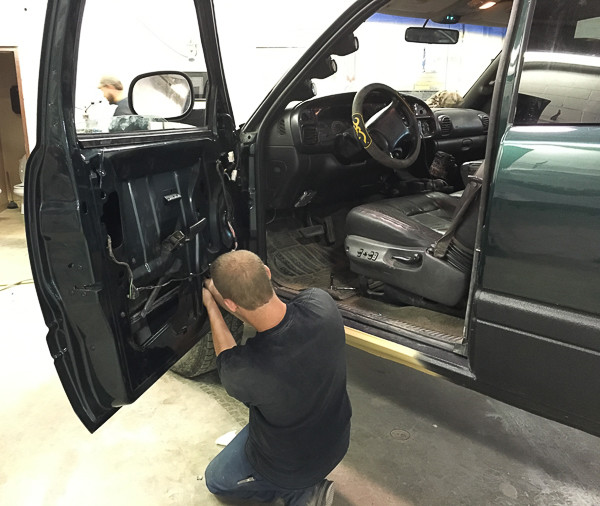
Mike McGraw, 23, a WCC alumnus now works at Campbell Collision in Brighton after graduating from WCC. Madi Tortora | Washtenaw Voice
BY IVAN FLORES
Contributor
The days are long, but the work is always different. This is what Mike McGraw, 23-year-old graduate from Washtenaw Community College’s collision repair program, says about his job at Campbell Collision in Brighton, Michigan.
“It varies day by day. Every accident is different. I never get bored… (But) your body can’t do it forever. I’d like to open up my own shop someday,” McGraw said.
Because of WCC’s elite automotive body repair department, with an emphasis on producing entry-level collision and custom fabrication technicians, it further assured McGraw of the possibility of finding employment after graduation while he pursued his degree. WCC’s program is one of only two programs certified by the National Automotive Technicians Education Foundation in Michigan.
WCC’s automotive program features state of the art equipment, four full-time and two part-time instructors with knowledge of the latest technology and procedures in the industry. For the people who pursue this path, collision repair technicians are in particularly high demand because of an aging workforce, and advances in technology and manufacturing have created a deficit of skilled workers. According to the United States Department of Labor, the job market for automotive repair is expected to grow 13 percent by 2022.
McGraw echoes the need for employers in this field. Although two other alumni were employed after completing their schooling at WCC, the demand is still rather high.
“A lot of guys are in their 50s and 60s, and retiring,” McGraw said. “There aren’t enough people to replace them.”
Collision technicians specialize in repairs after accidents occur. According to Scott Malnar, department chair of the Autobody Repair Department, there are four major areas of collision repair: refinishing, non-structural, electrical/mechanical and structural.
He explains that structural repairs are the most complicated and involve heavier equipment and the expertise to fix damaged car frames. Electrical/mechanical technicians work on things like engines, suspensions and the increasingly sophisticated electronic systems in cars. Non-structural technicians deal with relatively minor damage, such as dents and refinishers, and are responsible for the cosmetic aspects of vehicles.
To become a collision repair technician in Michigan, one must pass the Michigan certification test for collision, have at least two years of experience, and become certified by the National Institute for Automotive Service Excellence.
Washtenaw prepares individuals to meet these requirements through obtaining certificates. The most basic, auto body repair focuses on non-structural repair and prepares students for entry-level positions. The Collision Repair and Refinishing Technician certificate curriculum follows NATEF and ASE standards for all four major areas of collision repair.
NATEF and ASE assure that individuals are trained with knowledge of the latest advances in technology. For example, the 2015 Ford F-150 contains an extensive amount of high-strength aluminum in its frame, which requires different techniques for repair from the traditionally used steel. The change in materials is part of an effort to improve fuel economy, and the technology will presumably be used in other vehicles in the future.
“There have been other aluminum vehicles, like Audi, some of their cars are all made of aluminum…(but) now that the F-150 is made of aluminum, that’s a game changer for collision technicians. The Ford truck (is) the number one selling truck in the world,” Malnar said.
Donna Campbell, co-owner of Campbell Collision encourages students who are looking for work, school credits and experience to apply. They look for educated employees with a solid understanding of automotive mechanics – all obtainable through WCC’s top-notch auto body repair program.


